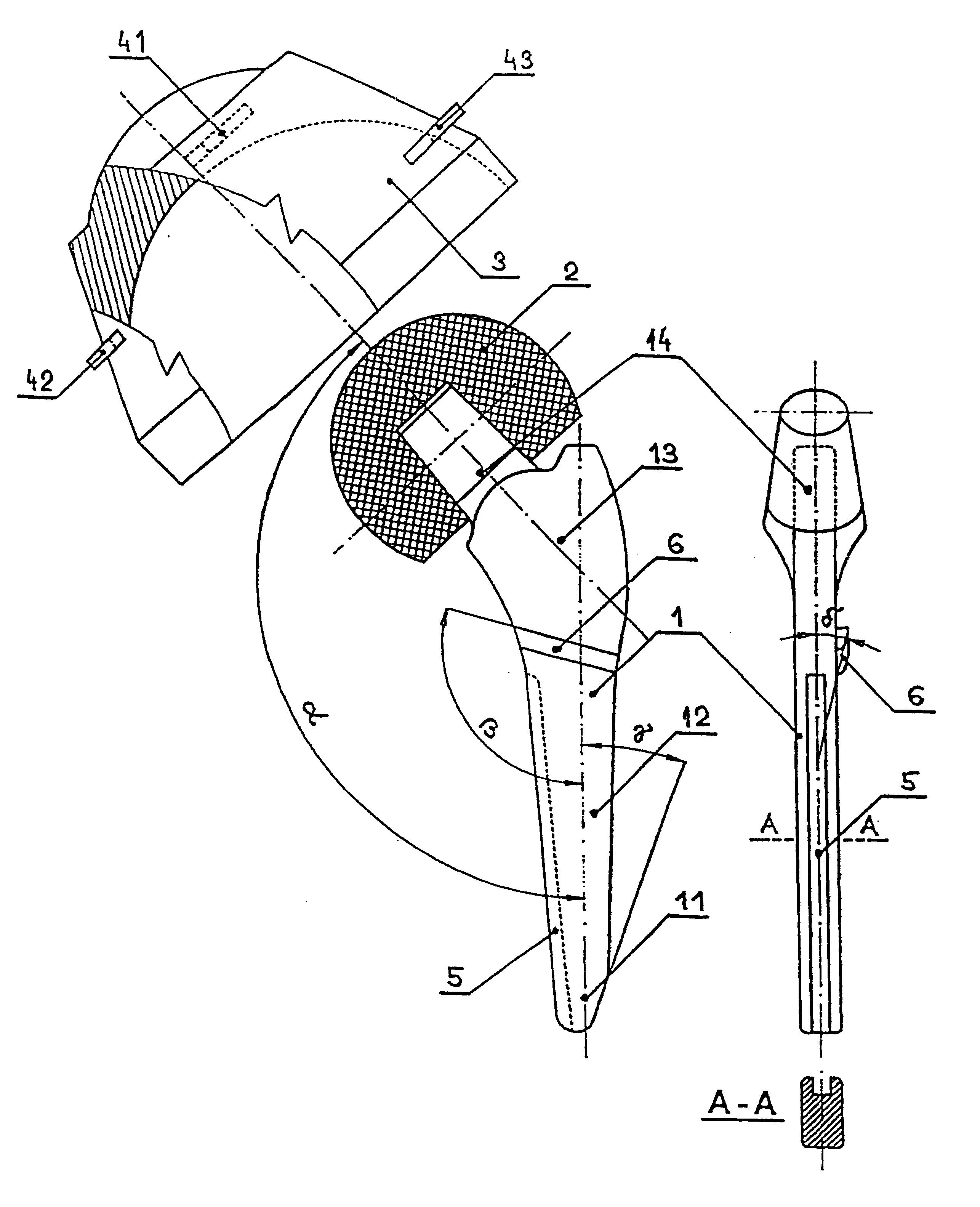Cementless total replacement of the human hip joint
a total replacement and cement technology, applied in hip joints, prosthesis, medical science, etc., can solve the problems of high price of these thr's, the disadvantage of cement's application, and the inability to protect the living biomaterial from rotation in the transversal plain or from protruding vertically,
- Summary
- Abstract
- Description
- Claims
- Application Information
AI Technical Summary
Benefits of technology
Problems solved by technology
Method used
Image
Examples
example 2
A total replacement of the human hip joint contains the acetabulum 3, which is constructed from stainless steel according to ISO 5832 / 211 whereas its shape is basically the same as in example 1 with the difference, that on its outer conical surface, which is covered with a nanocrystalline diamond layer 2 -4 nm thick, there are twelve self-drilling teeth arranged in a screwline in an angular spacing of 90.degree.. The first four teeth in the screwline (in the direction from the top of the acetabulum 3) have truncated pikes, the shape of the teeth corresponding to the embodiment in FIG. 7c, i.e. their cutting edge has a concave shape, but the 5th-12th tooth on the thread have a straight cutting edge and are sharp, i.e. have no truncated pikes (see FIG. 7a). The femoral component 1 (see FIG. 2), which is constructed from a titanium alloy of the type Ti-6Al-4V ELI contains on one main plain one 3 mm high and 3 mm wide transversal rib 6, which forms with the main axis of the wedge an ang...
example 3
The THR of the human hip joint contains an acetabulum 3 according to example 1 with the difference that all three teeth 41, 42 and 43 are sharp (shape according to FIG. 7a) and the femoral component 1 (see FIG. 3), which is constructed from stainless steel according to norm ISO 5832 / 211 and contains transversal ribs 6a, 6b, each 2 mm high and 2 mm wide, constructed on each main plain and two 3 mm high and 4 mm wide longitudinal ribs 71a, 72a, 71b, 72b made on each main plane and two grooves 5152 on the side plane in the lower part 11 and middle part 12 of the wedge 1.6 mm wide. The lower part 11, middle part 12 and the upper part 13 of the wedge are covered with a 5-8 .mu.m hydroxylapatite layer.
example 4
The total replacement of the human hip joint contains the acetabulum 3, according to FIG. 5, the outer surface of which including the self-drilling teeth 41, 42 and 43 are covered by a 3-5 .mu.m thick layer of hydroxylapatite and the femoral component 1 (see FIG. 4), which is constructed from stainless steel according to ISO 5832 / 211. The femoral component 1 contains the main body in the conical form ended in a standard cone, the axis of which forms with the main axis of the wedge an angle .alpha.=120.degree.. The wedge has on each main plain four 3 mm high and 3 mm wide longitudinal ribs 71a, 72a, 73a, 74a, 71b, 72b, 73b and 74b and three 2.5 mm high and 1.5 mm wide transversal ribs 61a, 62a, 63a, 61b, 62b and 63b which form with the main axis of the wedge an angle .beta.=100.degree.. All longitudinal ribs 71a, 72a, 73a, 74a, 71b, 72b, 73b and 74b have on the bottom end a tapering under the angle 45.degree.. The transversal ribs 61a, 62a, 63a, 61b, 62b and 63b are constructed in co...
PUM
 Login to View More
Login to View More Abstract
Description
Claims
Application Information
 Login to View More
Login to View More - R&D
- Intellectual Property
- Life Sciences
- Materials
- Tech Scout
- Unparalleled Data Quality
- Higher Quality Content
- 60% Fewer Hallucinations
Browse by: Latest US Patents, China's latest patents, Technical Efficacy Thesaurus, Application Domain, Technology Topic, Popular Technical Reports.
© 2025 PatSnap. All rights reserved.Legal|Privacy policy|Modern Slavery Act Transparency Statement|Sitemap|About US| Contact US: help@patsnap.com



